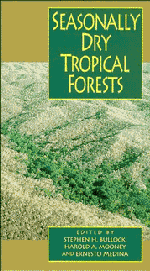Book contents
- Frontmatter
- Contents
- List of contributors
- Acknowledgements
- 1 Introduction
- 2 Dry forests of Central America and the Caribbean
- 3 Overview of the Brazilian caatinga
- 4 Savannas, woodlands and dry forests in Africa
- 5 Dry forest ecosystems of Thailand
- 6 The Cenozoic record of tropical dry forest in northern Latin America and the southern United States
- 7 Diversity and floristic composition of neotropical dry forests
- 8 Vertebrate diversity, ecology and conservation in neotropical dry forests
- 9 Diversity of life forms of higher plants in neotropical dry forests
- 10 Drought responses of neotropical dry forest trees
- 11 Plant reproduction in neotropical dry forests
- 12 Plant–herbivore interactions in Mesoamerican tropical dry forests
- 13 Biomass distribution and primary productivity of tropical dry forests
- 14 Nutrient cycling in tropical deciduous forests
- 15 Biology of the belowground system of tropical dry forests
- 16 Nitrogen trace gas emissions in a tropical dry forest ecosystem
- 17 Conversion of tropical dry forest to pasture and agriculture
- 18 Ethnobotany of the Mexican tropical dry forests
- Index
14 - Nutrient cycling in tropical deciduous forests
Published online by Cambridge University Press: 07 September 2010
- Frontmatter
- Contents
- List of contributors
- Acknowledgements
- 1 Introduction
- 2 Dry forests of Central America and the Caribbean
- 3 Overview of the Brazilian caatinga
- 4 Savannas, woodlands and dry forests in Africa
- 5 Dry forest ecosystems of Thailand
- 6 The Cenozoic record of tropical dry forest in northern Latin America and the southern United States
- 7 Diversity and floristic composition of neotropical dry forests
- 8 Vertebrate diversity, ecology and conservation in neotropical dry forests
- 9 Diversity of life forms of higher plants in neotropical dry forests
- 10 Drought responses of neotropical dry forest trees
- 11 Plant reproduction in neotropical dry forests
- 12 Plant–herbivore interactions in Mesoamerican tropical dry forests
- 13 Biomass distribution and primary productivity of tropical dry forests
- 14 Nutrient cycling in tropical deciduous forests
- 15 Biology of the belowground system of tropical dry forests
- 16 Nitrogen trace gas emissions in a tropical dry forest ecosystem
- 17 Conversion of tropical dry forest to pasture and agriculture
- 18 Ethnobotany of the Mexican tropical dry forests
- Index
Summary
Introduction
Nutrient cycling processes have been well documented for tropical moist forest (Vitousek & Sanford, 1986; Bruijnzeel, 1991) but few comprehensive syntheses exist for tropical and subtropical dry and deciduous forests (Lugo & Murphy, 1986; Singh, 1989). Tropical dry forests are considered among the most threatened tropical ecosystems (Janzen, 1988) because they experience considerable exploitative pressure (Murphy & Lugo, 1986). In India, such pressures have been responsible for the transformation of vast areas of deciduous forest into savanna (Singh, 1989). The current rate of destruction of deciduous forest makes it imperative that we gain a thorough understanding of nutrient cycling in the remaining intact and successional forests. At present one of the principal agricultural practices relies on forest slash burning, resulting not only in recurrent nutrient losses thereby affecting the long-term productivity of the system but also substantially contributing to emissions of C and N to the atmosphere (Kauffman, Sanford & Sampaio, 1990; Maass, Chapter 17).
Seasonally dry forest production is controlled by the amount and distribution of annual rainfall (Martínez-Yrízar, Chapter 13), and this may explain why nutrients have not been considered in detail (Murphy & Lugo, 1986; Singh, 1989). For example in a recent review of forest nutrient cycling there was only one reference to tropical dry forest (Vogt, Grier & Vogt, 1986). If we assume that water availability alone limits primary production in tropical deciduous forest, we could conclude that nutrient limitation is not important. However, multiple resource limitation of plant growth is common in natural communities (Chapin et al., 1987).
- Type
- Chapter
- Information
- Seasonally Dry Tropical Forests , pp. 346 - 361Publisher: Cambridge University PressPrint publication year: 1995
- 41
- Cited by



